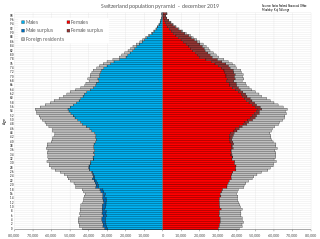
The population of Indonesia was 270.20 million according to the 2020 national census, an increase from 237.64 in 2010. Approximately 55% of Indonesia's population resides on Java, which is the most populous island in the world.
Jersey is the most populated of the crown dependencies and of the Channel Islands. The Demographic statistics of the island includes population density, ethnicity, education level, health of the populace, economic status, religious affiliations and other aspects of the population.

This article is about the demographic features of the population of Lithuania, including population density, ethnicity, level of education, health, economic status, and religious affiliations.

The demographics of Malaysia are represented by the multiple ethnic groups that exist in the country. Malaysia's population, according to the 2010 census, is 28,334,000 including non-citizens, which makes it the 42nd most populated country in the world. Of these, 5.72 million live in East Malaysia and 22.5 million live in Peninsular Malaysia. The population distribution is uneven, with some 79% of its citizens concentrated in Peninsular Malaysia, which has an area of 131,598 square kilometres (50,810.27 sq mi), constituting under 40% of the total area of Malaysia.

The demographics of Nauru, an island country in the Pacific Ocean, are known through national censuses, which have been analysed by various statistical bureaus since the 1920s. The Nauru Bureau of Statistics have conducted this task since 1977—the first census since Nauru gained independence in 1968. The most recent census of Nauru was in 2011, when population had reached ten thousand. The population density is 478 inhabitants per square kilometre, and the overall life expectancy is 59.7 years. The population rose steadily from the 1960s until 2006 when the Government of Nauru repatriated thousands of Tuvaluan and I-Kiribati workers from the country. Since 1992, Nauru's birth rate has exceeded its death rate; the natural growth rate is positive. In terms of age structure, the population is dominated by the 15–64-year-old segment (65.6%). The median age of the population is 21.5, and the estimated gender ratio of the population is 0.91 males per one female.

The demographics of New Zealand encompass the gender, ethnic, religious, geographic, and economic backgrounds of the 5.1 million people living in New Zealand. New Zealanders predominantly live in urban areas on the North Island. The five largest cities are Auckland, Wellington, Christchurch, Hamilton, and Tauranga. Few New Zealanders live on New Zealand's smaller islands. Waiheke Island is easily the most populated smaller island with 9,390 residents, while Great Barrier Island, the Chatham and Pitt Islands, and Stewart Island each have populations below 1,000. New Zealand is part of a realm and most people born in the realm's external territories of Tokelau, the Ross Dependency, the Cook Islands and Niue are entitled to New Zealand passports.

This article about the demographics of Switzerland features the population of the Swiss Confederation, including population density, ethnicity, education level, health of the populace, economic status, religious affiliations and other aspects of the population.

The Demographics of Venezuela are the condition and overview of Venezuela's peoples. Demographic topics include basic education, health, and population statistics as well as identified racial and religious affiliations.

This article is about the demographic features of the population of Albania, including population density, ethnicity, education level, health of the populace, economic status, religious affiliations and other aspects of the population. The demography of the Albania is monitored by the Institute of Statistics of Albania. The institute has performed demographic censuses since the 1924s. The latest census in Albania was performed in April 2011, and has been deemed as unreliable both within and outside Albania.

Education in Indonesia falls under the responsibility of the Ministry of Education, Culture, Research, and Technology and the Ministry of Religious Affairs. In Indonesia, all citizens must undertake twelve years of compulsory education which consists of six years at elementary level and three each at middle and high school levels. Islamic, Christian, Catholic, and Buddhist Schools are under the responsibility of the Ministry of Religious Affairs.
The National Center for Education Statistics (NCES) is the part of the United States Department of Education's Institute of Education Sciences (IES) that collects, analyzes, and publishes statistics on education and public school district finance information in the United States. It also conducts international comparisons of education statistics and provides leadership in developing and promoting the use of standardized terminology and definitions for the collection of those statistics. NCES is a principal agency of the U.S. Federal Statistical System.

Education in Mauritius is managed by the Ministry of Education & Human Resources, which controls the development and administration of state schools funded by government, but also has an advisory and supervisory role in respect of private schools. The Tertiary education is maintained by the Ministry of Tertiary Education, Science, Research and Technology. The government of Mauritius provides free education to its citizens from pre-primary to tertiary levels. Since July 2005, the government also introduced free transport for all students. Schooling is compulsory up to the age of 16. Mauritian students consistently rank top in the world each year for the Cambridge International O Level, International A and AS level examinations. Among sub-Saharan African countries, Mauritius has one of the highest literacy rates. According to The World Factbook - Central Intelligence Agency as of 2018, 91.3% of the population age 15 and over can read and write in Mauritius were respectively literate.

Literacy in India is a key for social-economic progress. The 2011 census, indicated a 2001–2011 literacy growth of 97.2%, which is slower than the growth seen during the previous decade. An old analytical 1990 study estimated that it would take until 2060 for India to achieve universal literacy at then-current rate of progress.
Education in Kentucky includes elementary school, middle school, high school, and post-secondary institutions. Most Kentucky schools and colleges are accredited through the Southern Association of Colleges and Schools (SACS).

Official statistics are statistics published by government agencies or other public bodies such as international organizations as a public good. They provide quantitative or qualitative information on all major areas of citizens' lives, such as economic and social development, living conditions, health, education, and the environment.

An Education index is a component of the Human Development Index published every year by the United Nations Development Programme. Alongside the Economical indicators and Life Expectancy Index, it helps measure the educational attainment, GNI (PPP) per capita and life expectancy are also used with the education index to get the HDI of each country.

The 2010 Chinese census, officially the Sixth National Population Census of the People's Republic of China (中華人民共和國第六次全國人口普查), was conducted by the National Bureau of Statistics of the People's Republic of China with a zero hour of November 1, 2010.
In previous years, students in the United States who have been diagnosed to have intellectual disabilities (ID) cannot have access or have difficulty having access to post-secondary education (PSE). One significant reason why these students have been marginalized from continuing their education is their being denied federal student aid. Many were disqualified due to the lack of having a high school diploma while others were not able to pass standardized tests which should indicate if their claim to secure aid is justified. With the legislation of the Higher Education Opportunity Act of 2008, students with ID can now qualify for student grants and work-study programs.

The 2020 Indonesian census was the 7th census in Indonesia. It was held in September 2020 by Statistics Indonesia. The resident Indonesia population was projected to be 269.6 million, a 13.4% increase from the 2010 census.















